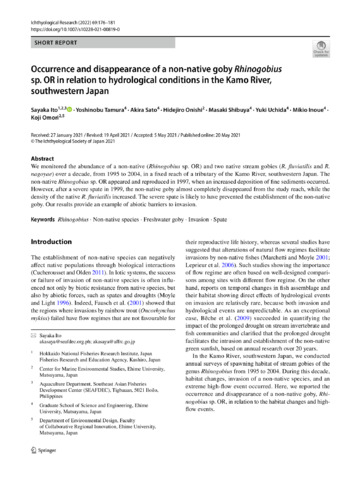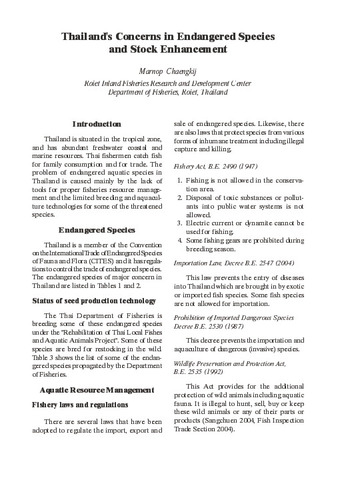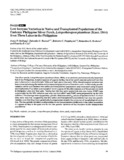| dc.contributor.author | Ito, Sayaka | |
| dc.contributor.author | Tamura, Yoshinobu | |
| dc.contributor.author | Sato, Akira | |
| dc.contributor.author | Onishi, Hidejiro | |
| dc.contributor.author | Shibuya, Masaki | |
| dc.contributor.author | Uchida, Yuki | |
| dc.contributor.author | Inoue, Mikio | |
| dc.contributor.author | Omori, Koji | |
| dc.date.accessioned | 2021-11-25T01:18:21Z | |
| dc.date.available | 2021-11-25T01:18:21Z | |
| dc.date.issued | 2021-10 | |
| dc.identifier.citation | Ito, S., Tamura, Y., Sato, A., Onishi, H., Shibuya, M., Uchida, Y., Inoue, M., & Omori, K. (2021). Effect of a non-native freshwater goby invasion on spawning habitat use of two native freshwater gobies. Environmental Biology of Fishes, 104(10), 1341–1351. | en |
| dc.identifier.issn | 0378-1909 | |
| dc.identifier.uri | http://hdl.handle.net/10862/6237 | |
| dc.description.abstract | We tracked the spawning habitat use of two native stream gobies (Rhinogobius fluviatilis and Rhinogobius nagoyae) before and during the invasion of a non-native goby (Rhinogobius sp. OR) and after its disappearance in the Tani River, Japan. Throughout the three phases, the majority of the two native gobies showed high preference and use for the habitat with medium-fast current velocity and coarse substrates as spawning sites. When the non-native Rhinogobius sp. OR invaded, the majority of them also preferred and used the same habitat as spawning sites, and the spawning habitat use of the three Rhinogobius species substantially overlapped. These results suggest that the invasion by the non-native goby did not significantly change the spawning habitat use of the two native gobies. However, the similar habitat requirement among the three Rhinogobius species may cause competition for the spawning habitat when the availability of their favorite habitat is greatly restricted. The non-native Rhinogobius sp. OR could utilize the spawning space on the undersurface of nest stones more efficiently than the two native gobies. Therefore, in the non-native Rhinogobius sp. OR, the size of nest stones is unlikely to be a limiting factor for reproductive success. Such ecological characteristics on nest stone use may enable Rhinogobius sp. OR to easily acquire nest stones with less competition in the spawning habitat where they coexist, which have also helped Rhinogobius sp. OR to extend its distribution area. | en |
| dc.description.sponsorship | This study was supported by the River Environment Fund (REF: 16–1-(4)-33), in charge of the Foundation of River and Watershed Environment Management (FOREM), Japan, and by grants from the 21st Century COE program of the Center for Marine Environmental Studies, Ehime University, Japan. | en |
| dc.language.iso | en | en |
| dc.publisher | Springer | en |
| dc.title | Effect of a non-native freshwater goby invasion on spawning habitat use of two native freshwater gobies | en |
| dc.type | Article | en |
| dc.citation.volume | 104 | |
| dc.citation.issue | 10 | |
| dc.citation.spage | 1341 | |
| dc.citation.epage | 1351 | |
| dc.citation.journalTitle | Environmental Biology of Fishes | en |
| dc.subject.asfa | introduced species | en |
| dc.subject.asfa | freshwater fishes | en |
| dc.subject.asfa | invasive species | en |
| dc.subject.asfa | non-native species | en |
| dc.identifier.essn | 1573-5133 | |
| dc.identifier.doi | 10.1007/s10641-021-01159-8 | |
| dc.subject.scientificName | Rhinogobius | en |
| dc.subject.scientificName | Rhinogobius fluviatilis | en |
| dc.subject.scientificName | Rhinogobius nagoyae | en |
| local.subject | Goby | en |
| local.subject | Invasion | en |
| local.subject | Spawning habitat | en |
| local.subject | Habitat shift | en |



